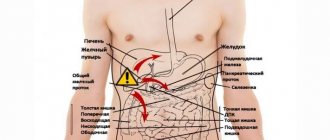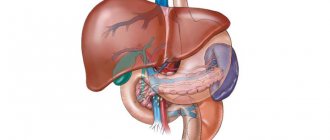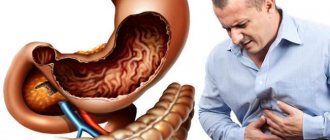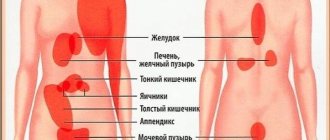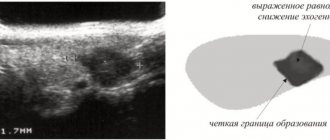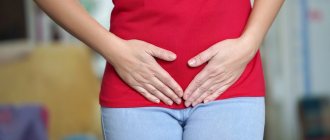The article was prepared by a specialist for informational purposes only. We urge you not to self-medicate. When the first symptoms appear, consult a doctor.
Pain is a symptom of trouble in the body. With this signal, he tries to communicate that some organ or organ system needs help. Therefore, pain cannot be ignored; it is necessary to find out its causes and eliminate them. Self-diagnosis can be dangerous; a doctor should be involved in detecting and treating the disease.
Pain in the lower abdomen in men is quite common. There can be many reasons for their occurrence. The article is intended to help understand them and orient a person to which specialist he needs to contact.
What organs are located in the lower abdomen of a man?
The lower part of the abdominal cavity is filled with various organs. Knowing their location, we can guess which organ is sending pain signals.
The following organs are located in the lower abdomen on the right side:
- Appendix;
- Cecum;
- The final section of the small intestine;
- The lower part of the right ureter.
The following organs are located in the suprapubic region:
- Small intestine;
- Bladder and part of the ureters;
- Prostate;
- Seminal vesicles.
The following organs are located in the lower abdomen on the left side:
- Rectum;
- Part of the small intestine;
- Sigmoid colon;
- Left ureter.
Painful sensations in the lower abdomen do not always indicate a pathology of the listed organs. Sometimes pain can radiate from other systems of the body that border them. This is possible thanks to an extensive network of nerve fibers that penetrate the entire human body.
When the lower back and lower abdomen hurt in the center
Pain concentrated in the center of the abdomen in its lower part most often indicates certain disturbances in the functioning of the organs of the urinary system, prostate gland or spinal column.
- Renal colic.
When the flow of urine through the ureter is disrupted, a person develops renal colic. The ureter is a thin tube that stretches from the kidney to the bladder. Passage failure most often occurs due to blockage of the ureter by stones. However, it cannot be ruled out that its obstruction occurred against the background of an inflammatory process, or that it was compressed by a tumor neoplasm. Moreover, the tumor can grow both from the organ itself and from tissues that are in close proximity to the ureter.
Pain with renal colic has the following features:
- The pain is paroxysmal.
- Pain forces a person to constantly move in order to find a position that will bring relief.
- The pain radiates to the groin, genitals, and pubis.
- The person’s general health is impaired, and nausea may occur.
- Body temperature may rise.
- There may be blood in the urine.
- Kidney pathologies.
A man may have an affected left ureter or kidney if he experiences the following symptoms:
- The pain is localized above the lumbar spine.
- The volume of urine increased, or, on the contrary, became insignificant.
- Body temperature has increased.
- The urine contains impurities of blood, pus, and mucus.
- The urine smells extremely unpleasant.
- Pathologies of the spinal column.
Pain in the lower abdomen and back is a symptom of many spinal pathologies: osteochondrosis, ankylosing spondylosis, spondylosis, etc.
In this case, the person will experience the following symptoms:
- The pain does not migrate and is localized in one area.
- The pain is not diffuse and has a clear localization.
- Pain shoots down my leg.
- The stool is not disturbed, there are no signs of poisoning, such as nausea and vomiting.
- In the morning, the pain hampers movement, and during the day it fades away.
- The lower limb on one side may lose sensitivity, sometimes there is a feeling that “goosebumps” are running over it.
First aid methods
If the doctor has not examined and diagnosed it, it is prohibited to take medications on your own. This can lead to many complications and aggravate symptoms. The following treatment methods are used depending on the cause of the pain syndrome:
- antispasmodics that eliminate increased tension in the muscle walls - Papaverine, Drotaverine, Halidor, No-shpa;
- the use of enzymes to stabilize the functioning of the pancreas, if an uncomfortable sensation develops after overeating, eating excessively fatty foods - Mezim, Creon, Ermital.
If enzymes and analgesics do not help, be sure to call an ambulance. While the patient is waiting for her, a cold compress can be applied to the abdomen, which will reduce painful symptoms. The towel is soaked in water or frozen food is placed inside. The compress can be used for a period of no more than 15 minutes.
There are a huge number of reasons that lead to increased pain in the navel area. It is impossible to independently identify the cause, since laboratory and instrumental diagnostic methods are required. Severe pain can be caused by a serious illness that requires immediate attention to the surgical department. For example, with the development of appendicitis, which needs to be removed in a short time. If a patient develops cancer, long-term therapy is required. Radiation and chemotherapy may need to be used, as well as surgical removal.
When the left lower abdomen hurts
The causes of pain in the lower abdomen on the left side may be as follows:
- Inflammation of the mucous membrane of the stomach and duodenum.
If a man has worsened gastritis or gastroduodenitis, this will necessarily result in abdominal pain. They are localized in the epigastric region and radiate to the left side. It is difficult to suspect gastroduodenitis on your own; you need to seek help from a specialist. Symptoms that may suggest inflammation of the digestive organs: heartburn, nausea, pain when pressing the center of the abdomen in its upper part.
- Enlargement of the spleen.
If the spleen increases in size, this will certainly manifest itself as pain in the left side in the lower abdomen, since the organ is located under the ribs on the left. Its expansion can occur against the background of inflammation of the organ, or with spasm of the venous vessels.
- Other symptoms that help to suspect an acute enlargement of the spleen in size: high body temperature, vomiting, pain in the lower abdomen on the left side.
- Splenic infarction.
If the flow of arterial blood to the spleen is disrupted, an infarction of the organ occurs. This is expressed by sharp pains that shoot from the left hypochondrium to the lower abdomen. When you try to take a deep breath, cough or move, the pain intensifies. Body temperature rises.
- Abscess of the spleen.
An abscess is a purulent lesion of an organ. It develops when pathogenic bacteria enter it. They are able to penetrate the spleen through the systemic bloodstream.
Symptoms of an organ abscess are:
- Pain in the left hypochondrium. It spreads to the chest and lower abdomen.
- Body temperature rises.
- My health is rapidly deteriorating.
- Weakness and nausea occur.
- Bend of the spleen.
This condition is characterized by volvulus of the artery that supplies the organ. The cause may be a congenital anomaly of the mesenteric ligaments or injury to the spleen. The following symptoms indicate volvulus of the artery: constipation and increased gas formation, vomiting, and poor health. The pain originates in the left hypochondrium and descends to the lower abdomen.
- Lymphocytic leukemia
or myeloid leukemia in chronic form.
Pain in these forms of blood cancer appears in the lower abdomen after eating. It can be felt by palpating the area. As the disease progresses, the pain becomes more severe. - Crohn's disease.
This disease is characterized by damage to the intestines and is manifested by the following symptoms:
- Pain that migrates throughout the abdominal cavity.
- Diarrhea and vomiting.
- Increased fatigue.
- Arthralgia.
- Lack of desire to eat.
- Polyposis.
Frequent inflammation of the intestines leads to the formation of polyps on its wall. These neoplasms are permeated with nerves, and therefore can manifest themselves as painful sensations when food masses pass through the intestines. Polyps must be removed, as they can become malignant.
- Nonspecific ulcerative colitis (UC).
With UC, the large intestine suffers, and the entire inside is covered with ulcers. The reasons for the development of pathology have not yet been established.
Symptoms of this form of colitis:
- High body temperature.
- In the early stages of the disease, pain is localized precisely on the left side of the abdomen, in its lower part.
- Bloating.
- Poor health.
- Unstable stool.
- Diverticulitis.
With diverticulitis, the intestinal walls become covered with protrusions that resemble small hernias. Diverticulitis affects older people. Sometimes the disease does not manifest itself at all and can only be detected by an x-ray using a contrast agent, and the study can be performed for a completely different reason.
- Appendicitis, with an atypical location of the appendix.
Appendicitis always manifests with pain in the upper abdomen, which then moves to the right side. However, when the process is located in an atypical place for it, the pain can radiate to the left side. As inflammation intensifies, pain increases. The nature of the pain is pulsating, cramping. In parallel, nausea and vomiting may occur, and sometimes diarrhea develops. Body temperature is most often elevated.
These symptoms are especially pronounced at a time when the disease worsens. During remission, the main symptoms do not bother the person.
When diverticula become inflamed, abdominal pain occurs, constipation develops, and body temperature rises.
Intestinal diseases
One of the most common causes of lower abdominal pain in men is irritable bowel syndrome (IBS) . It is a common condition, affecting 10–20% of adults worldwide4. IBS does not cause organ damage and is primarily associated with functional disorders of the digestive system4, 5.
There are two leading causes of the development of the disease: increased pain sensitivity of the intestines and disruption of its motor activity4. In this case, pain in men in the lower abdomen and intestinal spasm are inextricably linked, therefore, in case of IBS, antispasmodics - No-shpa® forte19 - can be used as an auxiliary therapy. The prescription of antispasmodics can be recommended for IBS, as they affect the main manifestations of the disease: they reduce pain and normalize stool frequency. In the study, the use of No-shpa®19 in 47% of patients with IBS contributed to a significant reduction in abdominal pain compared to 3% of patients taking placebo6.
Another cause of lower abdominal pain in men is diverticulosis (protrusion) of the colon . Diverticulosis is said to occur when there are many such protrusions in the intestine, but they do not manifest themselves in any way7. This disease is detected in 1/3 of the population over 60 years of age and in 2/3 over 80 years of age8. It can manifest itself as minor discomfort in the lower abdomen, or sudden severe pain, which is accompanied by intestinal bleeding8.
It is believed that the “weakness” of the intestinal wall, increased intracavitary pressure and a predisposition to the formation of diverticula occurs due to the predominance of food of animal origin in the diet and a lack of plant fiber (vegetables, fruits) in the diet. This is confirmed by the fact that diverticulosis occurs 3 times less often in vegetarians7.
When the lower abdomen hurts above the pubis
Pain concentrated in the lower abdomen directly above the pubis can characterize the following disorders in the body:
- Prostatitis in the acute phase.
When prostatitis worsens, the pain is sharp, stabbing, covers the entire perineum, extends to the testicles and groin, to the rectum and sacrum. If prostatitis worsens not for the first time, then the pain becomes nagging in nature. The cause of exacerbation of inflammation can be alcohol abuse, exposure to cold, and overwork.
- Cystitis.
When the bladder becomes inflamed, a man experiences the following symptoms:
- Pain when emptying the bladder, which prevents it from being completely emptied.
- Frequent urge to urinate.
- The appearance of blood in the urine.
- Urine becomes cloudy.
- The pain in the pubic area becomes nagging.
- Body temperature rises.
- If the disease is severe, vomiting and nausea may occur.
- Bladder cancer.
When the tumor reaches an impressive size, it begins to cause difficulty emptying the bladder. Blood impurities appear in the urine. Further progression of the disease resembles the symptoms of cystitis, lumbar pain and pain above the pubis are added, which cannot be eliminated by taking antispasmodics. Body temperature rarely increases with bladder cancer.
- BPH.
Urination becomes more frequent, and the man begins to wake up at night to empty his bladder. The prostate increases in size, which leads to the fact that a man begins to experience pain during urination. The sensations are sharp, stabbing. In addition to urinary retention, lower back pain is observed.
- Prostate cancer.
When the tumor grows, the first symptoms of the disease appear:
- Pain in the perineum.
- Frequent urge to urinate.
- Blood appears in urine and semen.
- The stream of urine loses its former pressure.
- Vesiculitis.
Inflammation of the seminal vesicles is manifested by the following symptoms:
In addition to pain, the man begins to worry about urinary problems. During emptying of the bladder, sharp pain in the abdomen will occur, and the urge becomes frequent. Possible urinary retention. In addition, erection suffers.
When the tumor begins to metastasize, the person will lose weight and lose appetite. Chest pain appears, weakness does not subside even after proper rest. When the skeleton is damaged, pain appears in the joints and bones.
- The pain spreads to the sacrum and becomes stronger during bowel movements or when the bladder is full.
- Pain always accompanies erection and ejaculation.
- Blood impurities appear in the semen.
- Urination is impaired.
- General health is disturbed.
Diseases that manifest as pain to the right of the navel
Most often, pain at the navel level indicates dysfunction of the small or large intestine. Pain causes inflammation of the mucous membrane, degenerative process, poor circulation, blockage of the intestinal lumen, accumulation of gases and feces.
In addition to pain, gastrointestinal diseases cause nausea, vomiting, and abnormal bowel movements. The set of symptoms that occur simultaneously with abdominal pain near the navel on the right side will help determine where the pathology develops.
Enteritis
Inflammation of the small intestine, which leads to dystrophic processes. Pathology is formed after intestinal infection by bacteria, viruses, parasites, helminths, aggressive action of chemicals or nutritional disorders.
Inflammation can also develop during long-term use of medications, as well as when a person is prone to alcohol, spicy and rough foods. If the inflammatory process occurs in the jejunum, then jeunitis is diagnosed, and if in the ileum, then ileitis.
If the inflammation affects all parts of the small intestine, then they speak of total enteritis. All diseases are characterized by a violation of absorption function, the process of breaking down food, the production of certain enzymes or their activity.
In the acute course of the disease, the patient is bothered by diarrhea (10–15 times a day), nausea, vomiting, and cramping pain near the navel on the right or left. Hyperthermia and headache are sometimes noted. The person also experiences weakness, dry and pale skin, a white coating on the tongue, gurgling in the stomach and gas retention.
With prolonged diarrhea, dehydration appears, muscle cramps and hemorrhagic diathesis may occur.
With chronic enteritis, extraintestinal manifestations are also observed (lack of vitamins, anemia, osteoporosis, dystrophy). Defecation can be up to 5 times a day, after which weakness, decreased blood pressure, dizziness, and tremors of the limbs occur. When there is inflammation of the intestines, there is a white coating on the tongue, and marks from the teeth are visible along the edges.
The abdomen is enlarged; when palpating the intestines, noise and splashing are heard.
Intestinal infarction
In pathology, mesenteric circulation is impaired. Thrombosis, embolism, non-occlusive ischemia, atherosclerosis most often appear against the background of severe heart disease. The average age of patients diagnosed with intestinal infarction is seventy years, but recently the pathology is developing more and more often in patients under 30 years of age.
The first stage lasts up to six hours. At this time, the patient suffers from severe cramping pain in the abdomen. The location of the pain depends on where the necrosis of the intestinal wall has developed. With ischemia of the small intestine, pain appears near the navel. If the ascending or cecum is affected, then it occurs in the right side of the abdomen, and if the transverse colon or descending colon, then in the left.
And although the pain is severe, the abdomen remains soft and almost does not hurt during palpation. At the beginning of the disease, peristalsis is increased, but within a few hours it weakens. The disease usually develops rapidly, but it happens that the symptoms increase gradually. In addition to severe stomach pain, nausea, diarrhea, and vomiting occur.
As the intestinal wall becomes necrotic, the pain disappears, but, naturally, the patient’s condition does not improve. Signs of intoxication and dehydration appear, convulsions begin, and coma sets in.
Circulatory disorders
Pain in the navel area on the right is due to deterioration of blood circulation in the intestinal loops. Most often, this is caused by blocking the lumen of the mesenteric vessels, which is why the intestinal tissues do not receive the required amount of nutrients and oxygen.
Chronic ischemia occurs against the background of atherosclerosis, when atherosclerotic plaques interfere with blood circulation, which is why severe pain appears in the navel area on the right half an hour after eating. At the beginning of the development of ischemia, nausea, vomiting, and diarrhea mixed with blood occur. As the pathology develops, constipation, weight loss, flatulence, and gurgling in the intestines are added.
Appendicitis
At the initial stage of inflammation of the appendix, the patient feels pain on the right side of the navel, only after two hours it is felt in the area of the appendix. The disease is also indicated by the sudden onset of pain and its intensification when changing body position, laughing, coughing.
A person with acute appendicitis is forced to take a forced position of the body; as a rule, the pain intensifies if lying on the left side
Early manifestations of inflammation include nausea, single vomiting, gas and stool retention, diarrhea, fever to febrile levels, pulse up to 90–100 beats per minute. With chronic appendicitis, aching pain occurs in the right hypochondrium, it intensifies after physical activity, and digestion is also disrupted.
Unlike acute appendicitis, the temperature is normal, urine and blood tests do not show an increased level of leukocytes, and inflammation does not develop so rapidly.
Intestinal hernia
Pain to the right of the navel appears if there is an umbilical hernia. This pathology is mainly found in children, but can also be diagnosed in adults, more often in women after pregnancy. In children, intestinal loops prolapse due to the structural features of the umbilical ring, and in adults, due to a peritoneal diverticulum in the umbilical area.
Pain near the navel in a child
A hernial protrusion can be seen when a person is in a horizontal position. As a rule, in children by the age of five, a hernia in the umbilical ring area goes away on its own. Discomfort in the area of the umbilical hernia may appear after physical activity, coughing, laughing, or straining.
An uncomplicated hernia is characterized by nausea, belching, and constipation. With an unreducible hernia, trauma to the hernial sac is likely, which leads to impaired circulation of blood and lymph in the intestine and a deterioration in its function.
A complication is strangulation of the intestinal loops, which causes poor circulation, resulting in tissue necrosis, paresis of the intestinal wall, gangrene or perforation.
Making a diagnosis depending on the nature of the pain
| The pain is dull. |
|
| The pain is acute. |
|
| The pain occurs like contractions. |
|
| The pain is sharp. |
|
| The pain is aching. |
|
| The pain is nagging. |
|
| The pain is cutting. |
|
| The pain is very intense. |
|
Making a diagnosis based on additional symptoms
To determine the cause of pain, it is not enough just to know the symptoms; you should start from what exactly accompanied its onset.
- Pain and connection with certain events.
If pain occurs immediately after emptying the bladder, this may indicate inflammation.
If before the onset of pain a man was in the cold for a long time, then his prostatitis or cystitis could worsen.
If pain occurs after intimacy, it may signal vesiculitis or prostatitis.
If pain manifests itself after eating, it may be a symptom of irritable bowel disease. In addition, with nervous tension, a man will experience the urge to have a bowel movement, and after going to the toilet he will feel as if the act of defecation is not completely completed. This syndrome is also characterized by alternating constipation and diarrhea.
- High body temperature.
If, against the background of pain in the lower abdomen, body temperature rises, this may be a sign of the following pathologies:
- Infectious inflammation of the seminal vesicles.
- Acute inflammation of the prostate gland.
- Diverticulitis.
- Kidney inflammation.
- Urolithiasis, causing renal colic.
- Inflammation of the appendix.
- Severe cystitis.
- Crohn's disease.
- Pathology of the spleen.
- Pain on palpation.
If a man experiences pain in the lower abdomen when palpating the peritoneum, this may indicate the following pathologies:
- Inflammation of the appendix.
- Intestinal abscess.
- Splenic infarction.
- Diverticulitis.
Necessary studies to make a diagnosis
To determine the true cause of a man’s pain, which is localized in the lower abdomen, he will need to visit a doctor. This could be a gastroenterologist or urologist.
During your initial visit you will need to go through the following procedures:
- Answer the doctor’s questions regarding how long the man has been bothered by pain, and whether it is related to other situations. The doctor will be interested in how intense the pain is, what its nature is, and where exactly it is concentrated.
- After the interview, the doctor will begin to palpate the abdominal wall. You may need to palpate the prostate, which is done through the rectum.
- If necessary, the specialist will give the patient a referral for the following diagnostic procedures:
- Ultrasound of organs located in the abdominal cavity.
- Ultrasound of the prostate.
- Contrast X-ray examination of the intestine.
- Ultrasound of the pancreas.
- Ultrasound of the urinary system.
If a tumor is detected, tissue sampling will be required. A biopsy is most often performed during surgery, when, after excision of the tumor, a small part of it is separated and sent for histological analysis. Before a patient is referred for surgery, a number of preparatory measures are carried out, including an MRI or CT scan.
If the doctor suspects a pathology of the urinary tract, then you will need to submit your urine for analysis according to Nechiporenko and for bacteriological culture.
If a patient is diagnosed with prostatitis, then a bacteriological analysis of prostate juices is necessary.
Diagnostic methods
To find out the exact localization of the pathological process, it is recommended to consult with the following attending physician:
- surgeon, oncologist;
- urologist, gynecologist, proctologist;
- gastroenterologist
If there are no pathogenetic, characteristic symptoms, it is recommended to consult a therapist. He will conduct general tests, examination, prescribe laboratory and instrumental tests, and palpate the abdominal area. Depending on the results of diagnostic tests, the patient is referred further to a specialist doctor.
The following diagnostic tests are considered the most informative:
- general analysis of blood, urine and feces;
- blood chemistry;
- radiography, magnetic resonance imaging;
- Ultrasound of the abdominal and pelvic organs;
- biopsy followed by histological examination;
- colposcopy, hysterography;
- blood test for the presence of tumor markers.
During the treatment process, tests are repeated to determine the presence or absence of results from the applied therapy methods.
Treatment
Therapeutic tactics depend on the specific diagnosis given to the patient. Surgery is performed for splenic infarction, appendicitis, intestinal abscess, prostate adenoma.
Irritable bowel syndrome, Crohn's disease, and prostate inflammation require correction with medications.
Oncological tumors are always removed. Depending on the type of tumor, chemotherapy or radiation therapy is prescribed, and sometimes both of these methods are combined.
Author of the article:
Lebedev Andrey Sergeevich |
Urologist Education: Diploma in the specialty “Andrology” received after completing residency at the Department of Endoscopic Urology of the Russian Medical Academy of Postgraduate Education at the urological center of the Central Clinical Hospital No. 1 of JSC Russian Railways (2007). Postgraduate studies were also completed here in 2010. Our authors
What are the causes of cramping pain?
The pain is not always sharp and severe. It may resemble contractions, muscle spasms that intensify in the area of the umbilical ring.
Similar symptoms are provoked by the following pathological conditions in the body:
- adhesions between the intestinal walls;
- Crohn's disease is a chronic inflammatory process in the intestines that provokes the formation of granulomas;
- ulcerative colitis - the formation of ulcers on the intestinal walls, after which scars form, making muscle contraction difficult;
- megacolon - hypertrophy of the walls of the colon, which become denser, with reduced function.
With the listed pathologies, not only cramping pain develops around the navel. The patient is characterized by increased gas formation and dyspeptic disorders. They intensify if he overeats or performs excessive physical activity.
